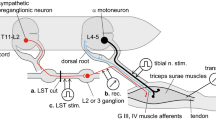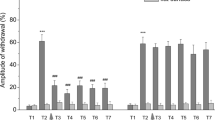Abstract
Cuticular strain associated with support of the shell of the hermit crab, Pagurus pollicarus, by its abdomen activates mechanoreceptors that evoke a stereotyped reflex in postural motoneurons. This reflex consists of three phases: a brief high-frequency burst of motoneuron spikes, a pause, and a much longer duration but lower frequency period of spiking. These phases are correlated with a rapid increase in muscle force followed by a slight decline to a level of tone that is greater than that at rest but less than maximal. The present experiments address the mechanisms underlying the transition from the first to second phase of the reflex and their role in force generation. Although centrally generated inhibitory post-synaptic potentials (IPSPS) are present during the pause period of the reflex, intracellular current injection of motoneurons reveals a spike frequency adaptation that rapidly and substantially reduces motoneuron firing frequency and is unchanged in saline that reduces synaptic transmission. The adaptation is voltage sensitive and persists for several hundred milliseconds upon repolarization. Hyperpolarization partially restores the initial response of the motoneuron to depolarizing current. Spike frequency adaptation and synaptic inhibition are important mechanisms in the generation of force that maintains abdominal stiffness at a constant, submaximal level.








Similar content being viewed by others
Abbreviations
- VSMN :
-
Ventral superficial muscle motoneurons
- PSDF :
-
Probability spike density function
- HCM :
-
High Ca2+, high Mg2+ Cole’s saline
- LCHM :
-
Low Ca2+, high Mg2+ Cole’s saline
References
Alaburda A, Perrier JF, Hounsgaard J (2002) An M-like outward current regulates the excitability of spinal motoneurones in the adult turtle. J Physiol 540:875–881
Atwood HL (1967) Crustacean neuromuscular mechanisms. Am Zool 7:527–552
Binder M, Heckman C, Powers RK (1996) The physiological control of motoneuron activity. In: Rowell L, Shepherd J (eds) Handbook of physiology. Exercise: regulation and integration of multiple systems. Oxford University Press, New York, pp 1–53
Buller AJ, Lewis DM (1965) The rate of tension development in isometric tetanic contractions of mammalian fast and slow skeletal muscle. J Physiol 176:337–354
Chapple WD (1969) Postural control of shell position by the abdomen of the hermit crab, Pagurus pollicarus. J Exp Zool 171:4, 397:408
Chapple WD (1973a) Changes in abdominal motoneuron frequency correlated with changes of shell position in the hermit crab, Pagurus pollicarus. J Comp Physiol A 87:49–64
Chapple WD (1973b) Role of the abdomen in the regulation of shell position in the hermit crab Pagurus pollicarus. J Comp Physiol A 82:317–332
Chapple WD (1974) Hydrostatic pressure changes in the abdomen of the hermit crab, Pagurus pollicarus, during movement. J Comp Physiol A 88:399–412
Chapple WD (1997) Regulation of muscle stiffness during periodic length changes in the isolated abdomen of the hermit crab. J Neurophysiol 78:1491–1503
Chapple WD (2002) Mechanoreceptors innervating soft cuticle in the abdomen of the hermit crab, Pagurus pollicarus. J Comp Physiol A 188:753–766
Chapple WD, Krans JL (2004) Cuticular receptor activation of postural motoneurons in the abdomen of the hermit crab, Pagurus pollicarus. J Comp Physiol A 190:365–377
Evoy WH (1977) Crustacean motor neurons. In: Hoyle G (ed) Identified neurons and behavior of arthropods. Plenum Press, New York, pp 67–86
Gabriel JP, Scharstein H, Schmidt J, Buschges A (2003) Control of flexor motoneuron activity during single leg walking of the stick insect on an electronically controlled treadwheel. J Neurobiol 56:237–251
Gillary HL, Kennedy D (1969) Pattern generation in a crustacean motoneuron. J Neurophysiol 32:595–606
Granit R (1970) The basis of motor control: integrating the activity of muscles, alpha and gamma motoneurons and their leading control systems. Academic, London
Grillner S, Deliagina T, Ekeberg O, el Manira A, Hill RH, Lansner A, Orlovsky GN, Wallen P (1995) Neural networks that co-ordinate locomotion and body orientation in lamprey. Trends Neurosci 18:270–279
Guckenheimer J, Harris-Warrick R, Peck J, Willms A (1997) Bifurcation, bursting, spike frequency adaptation. J Comput Neurosci 4:257–277
Harris-Warrick RM (2002) Voltage-sensitive ion channels in rhythmic motor systems. Curr Opin Neurobiol 12:646–651
Heckman CJ, Lee RH, Brownstone RM (2003) Hyperexcitable dendrites in motoneurons and their neuromodulatory control during motor behavior. Trends Neurosci 26:688–695
Jorge-Rivera JC, Sen K, Birmingham JT, Abbott LF, Marder E (1998) Temporal dynamics of convergent modulation at a crustacean neuromuscular junction. J Neurophysiol 80:2559–2570
Kernell D (1965) Synaptic influence on the repetitive activity elicited in cat lumbosacral motoneurones by long-lasting injected currents. Acta Physiol Scand 63:409–410
Le Bon-Jego M, Cattaert D (2002) Inhibitory component of the resistance reflex in the locomotor network of the crayfish. J Neurophysiol 88:2575–2588
Lee RH, Kuo JJ, Jiang MC, Heckman CJ (2003) Influence of active dendritic currents on input–output processing in spinal motoneurons in vivo. J Neurophysiol 89:27–39
Lewis DV, Huguenard JR, Anderson WW, Wilson WA (1986) Membrane currents underlying bursting pacemaker activity and spike frequency adaptation in invertebrates. Adv Neurol 44:235–261
Lindsey BG, Gerstein GL (1979) Interactions among an ensemble of chordotonal organ receptors and motor neurons of the crayfish claw. J Neurophysiol 42:383–399
Magarinos-Ascone C, Nunez A, Delgado-Garcia JM (1999) Different discharge properties of rat facial nucleus motoneurons. Neuroscience 94:879–886
Martin MM (2002) Changes in electrophysiological properties of lamprey spinal motoneurons during fictive swimming. J Neurophysiol 88:2463–2476
Morris LG, Hooper SL (1997) Muscle response to changing neuronal input in the lobster (Panulirus interruptus) stomatogastric system: spike number- versus spike frequency-dependent domains. J Neurosci 17:5956–5971
Morris LG, Hooper SL (1998) Muscle response to changing neuronal input in the lobster (Panulirus interruptus) stomatogastric system: slow muscle properties can transform rhythmic input into tonic output. J Neurosci 18:3433–3442
Msghina M, Govind CK, Atwood HL (1998) Synaptic structure and transmitter release in crustacean phasic and tonic motor neurons. J Neurosci 18:1374–1382
Parker D (2003) Activity-dependent feedforward inhibition modulates synaptic transmission in a spinal locomotor network. J Neurosci 23:11085–11093
Parker D, Newland PL (1995) Cholinergic synaptic transmission between proprioceptive afferents and a hind leg motor neuron in the locust. J Neurophysiol 73:586–594
Phares GA, Antzoulatos EG, Baxter DA, Byrne JH (2003) Burst-induced synaptic depression and its modulation contribute to information transfer at aplysia sensorimotor synapses: empirical and computational analyses. J Neurosci 23:8392–8401
Phelan P, Starich TA (2001) Innexins get into the gap. Bioessays 23:388–396
Prather JF, Clark BD, Cope TC (2002) Firing rate modulation of motoneurons activated by cutaneous and muscle receptor afferents in the decerebrate cat. J Neurophysiol 88:1867–1879
Sawczuk A, Powers RK, Binder MD (1995a) Intrinsic properties of motoneurons. Implications for muscle fatigue. Adv Exp Med Biol 384:123–134
Sawczuk A, Powers RK, Binder MD (1995b) Spike frequency adaptation studied in hypoglossal motoneurons of the rat. J Neurophysiol 73:1799–1810
Schmidt J, Fischer H, Buschges A (2001) Pattern generation for walking and searching movements of a stick insect leg. II. Control of motoneuronal activity. J Neurophysiol 85:354–361
Swensen AM, Golowasch J, Christie AE, Coleman MJ, Nusbaum MP, Marder E (2000) GABA and responses to GABA in the stomatogastric ganglion of the crab Cancer borealis. J Exp Biol 203:2075–2092
Taylor JR (1982) An introduction to error analysis: the study of uncertainties in physical measurements. University Science Books, Mill Valley
Wachowiak M, Cohen LB (1998) Presynaptic afferent inhibition of lobster olfactory receptor cells: reduced action-potential propagation into axon terminals. J Neurophysiol 80:1011–1015
Zucker RS, Regehr WG (2002) Short-term synaptic plasticity. Annu Rev Physiol 64:355–405
Acknowledgements
We would like to thank Andrew Moiseff and Elizabeth W. Kelly for their insightful discussions and helpful comments on the manuscript. We are grateful to Joseph Healy, who provided animals. This research was supported in part by NSF grant IBN-9874499.
Author information
Authors and Affiliations
Corresponding author
Rights and permissions
About this article
Cite this article
Krans, J.L., Chapple, W.D. The action of spike frequency adaptation in the postural motoneurons of hermit crab abdomen during the first phase of reflex activation. J Comp Physiol A 191, 157–174 (2005). https://doi.org/10.1007/s00359-004-0581-9
Received:
Revised:
Accepted:
Published:
Issue Date:
DOI: https://doi.org/10.1007/s00359-004-0581-9




